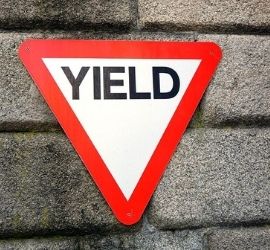What is the SEC Yield?
 The SEC yield is a standard yield calculation developed by the U.S. Securities and Exchange Commission (SEC). It allows for fairer comparisons of bond funds. It is based on the most recent 30-day period covered by the fund’s filings with the SEC. The yield figure reflects the dividends and interest earned during the period after the deduction of the fund’s expenses. It is also referred to as the standardized yield.
The SEC yield is a standard yield calculation developed by the U.S. Securities and Exchange Commission (SEC). It allows for fairer comparisons of bond funds. It is based on the most recent 30-day period covered by the fund’s filings with the SEC. The yield figure reflects the dividends and interest earned during the period after the deduction of the fund’s expenses. It is also referred to as the standardized yield.
The yield calculation shows investors what they would earn in yield over the course of a 12-month period. Of course, this is only if the fund continued earning the same rate for the rest of the year. The 30-day SEC yield requires every fund to calculate this particular yield number the same way. The 30-day yield doesn’t represent the actual yield of a mutual fund. However, it provides investors with a projected estimate of earnings. This calculation is based on the current market value on the date of the calculation. It provides a backward look into the fund’s actual, recent 30-day history.
This calculation is based on a 30-day period ending on the last day of the previous month. It is computed by dividing the net investment income per share earned during the period by the maximum offering price per share on the last day of the period. The figure listed lags by one month. When a dash appears, the yield available is more than 30 days old. This information is taken from fund surveys. (Source:morningstar)
The SEC yield is used to compare bond funds in a standardized way. It captures and estimates the effective rate of interest an investor may receive in the future. It is widely considered a good way to compare mutual funds or exchange-traded funds (ETFs). This is because this yield measure is generally very consistent from month to month. The calculation shows investors what they would earn in yield over the course of a 12-month period. This is assuming the fund continued earning the same rate for the rest of the year. The SEC makes it mandatory for funds to calculate this yield. The SEC yield differs from the Distribution Yield, which is typically displayed on a bond’s website.
SEC Yield Calculation
Most funds calculate a 30-day SEC yield on the last day of each month, though U.S. money market funds calculate and report a seven-day SEC yield. The standardized formula for the 30-day SEC yield consists of four variables:
- a = interest and dividends received over the last 30-day period
- b = accrued expenses over the last 30-day period, excluding reimbursements
- c = the average number of shares outstanding, on a daily basis, which was entitled to receive distributions
- d = the maximum price per share on the day of the calculation, the last day of the period
The formula of the annualized 30-day SEC yield is:
2 x (((a – b) / (c x d) + 1) ^ 6 – 1)
Example Calculation
Assume Investment Fund X earned $12,500 in dividends and $3,000 in interest. The fund also recorded $6,000 worth of expense, of which $2,000 was reimbursed. The fund has 150,000 shares entitled to receive distributions, and on the last day of the period, the day the yield is being calculated, the highest price the shares reached was $75. In this scenario, the variables equal:
- a = $12,500 + $,3000 = $15,500
- b = $6,000 – $2,000 = $4,000
- c = 150,000
- d = $75
Once these numbers are plugged into the formula, it looks like this:
30-day yield = 2 x ((($15,500 – $4,000) / (150,000 x $75) + 1) ^ 6 – 1), or 2 x (0.00615) = 1.23%
Source:investopedia
SEC Yield Advantages
The SEC yield is so named because companies are required to report this figure to the Securities and Exchange Commission. The SEC yield figure approximates the yield an investor would receive in a year. However, it assumes that each bond in the portfolio is held until maturity. This measure also assumes reinvestment of all income and accounts for management fees and expenses. Some analysts and financial reporters believe there is a lack of clarity around bond yield calculations. They believe that the SEC calculation provides:
- Greater accuracy – a more accurate result than the various distribution yield calculations.
- Consistent – It is more consistent on a month-to-month basis. In fact, whether one calculation will come closer to the following 12-month yield than another is, to some extent, a matter determined by the market.
- Based on historical data – All yield calculations are reports on what has already happened, not what’s to come.
- Assumes bonds will be held to maturity – The different distribution yield calculation variants make assumptions that may or may not represent reality. So does the SEC calculation any actively managed fund companies almost never hold all bonds until their maturities.
- Standardized comparison – The undeniable advantage of the SEC yield is that it is standardized—now investors can compare apples to apples.
SEC Yield vs Distribution Yield
Many sources report a distribution yield for a fund, based on the distributions it actually made. The SEC yield is a better estimate of future returns. The distribution yield is a better estimate of the types of returns which may affect the taxability of those returns. For example, dividends versus capital appreciation or depreciation. One aspect of distribution yield appraisal is that not every fund calculates it in quite the same way. This is a major weakness in trying to understand the significance of a bond fund’s posted distribution yield. Here are some other weaknesses of using distribution yield:
Distribution Yield Calculation Flaws
- Rounding and estimation errors – An obvious issue is the often-inaccurate assumption that the income over the last 30 days multiplied by 12 equals the 12-month return. In many instances, this is a reasonably close approximation of the actual 12-month return. At other times, however, the calculated average income and the actual income may be quite different.
- Different number of days in a month – There is another assumption that may compromise the distribution yield calculation’s accuracy. Not every month has the same number of days. If you calculate the return at the end of February, you’re using a 28-day distribution period. If you calculate it in May, you’re using a 31-day period. A fund that yields X dollars in 28 days has a return rate that is at least a few percent higher than the same X yield spread over 30 days. This difference can skew the result a little further.
- Net asset values change – The third assumption is that the current NAV represents the average NAV over the past 12 months. There’s no reason to assume that this is accurate. It is like assuming that today’s stock price for Amazon or Microsoft is its average price over the past year.
The calculation of distribution yield is not standardized. A common definition is the ratio of distributions over the last year to the fund price. Bond A has a 2.00% distribution yield, and Bond B has a 2.75% distribution yield. Regardless of what happens to yields, Bond A and Bond B will have almost the same total return. Bond B will pay a higher dividend, but will rise less or fall more in price for any change in rates. (Source:bogleheads.org)
SEC Yield vs Distribution Yield – Final Words
The 30-day SEC yield and the distribution yield of a mutual fund may show significantly different numbers. Investors should understand that the SEC yield is the conservative estimate of what an investor should earn over the next 12 months. Neither yield takes into account the effect of changing share prices on the total return. Besides looking at the reported yield numbers, an investor should look up the actual dividend history. This will reveal if the distribution rate has been increasing, decreasing or staying consistent.
Up Next: What Is Economic Value Added (EVA)?
Economic value added (EVA) is a measure of a company’s financial performance. It is based on the residual wealth calculated by deducting its cost of capital from its operating profit. The measure is adjusted for taxes on a cash basis. EVA can also be referred to as economic profit. This is because it attempts to capture the true economic profit of a company. The measure was devised by management consulting firm Stern Value Management. The company was originally incorporated as Stern Stewart & Co.
EVA is used to measure the value a company generates from funds invested in it. However, EVA relies heavily on invested capital and is best used for asset-rich companies. Companies with intangible assets, such as technology businesses, may not be good candidates.



